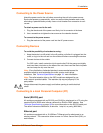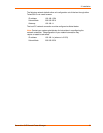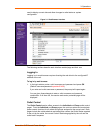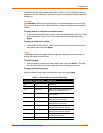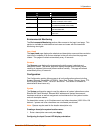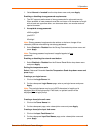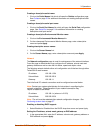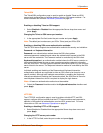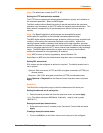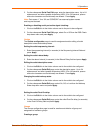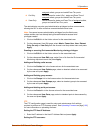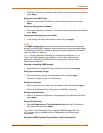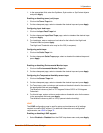
3: Operations
Telnet/SSH
The Telnet/SSH configuration page is used to enable or disable Telnet and SSH
support and configure the port number that the Telnet or SSH server watches. For
more information on SSH see
Advanced Operations on page 66.
Enabling or disabling Telnet or SSH support:
1. Select Enabled or Disabled from the appropriate Server drop-down menu and
press Apply.
Changing the Telnet or SSH server port number:
1. In the appropriate Port field, enter the port number and press Apply.
Note: The default port numbers are: port 23 for Telnet, and port 22 for SSH.
Enabling or disabling SSH server authentication methods:
The SLP SSH server supports two authentication methods for security and validation:
Password and Keyboard-Interactive.
Password is an authentication method where the SSH client gathers
username/password credentials and makes the authentication request to the SSH
server with the credentials. The Password method is controlled by the SSH client.
Keyboard-Interactive is an authentication method where the SSH server controls an
information field followed by one or more prompts requesting credential information
from the SSH client. The client gathers credential information keyed-in by the user and
sends it back to the server. The Keyboard-Interactive method is controlled by the SSH
server.
Individual enabling and disabling of the Password and Keyboard-Interactive
authentication methods are supported to allow an SSH client to be forced to use a
specific method. Although both methods are available, by enabling the Keyboard-
Interactive method and disabling the Password method, the SSH client is forced to
used Keyboard-Interactive, which is required to display the login banner.
Note: At least one authentication method must be enabled.
1. Select the Password checkbox and/or the Keyboard-Interactive checkbox and
press Apply.
HTTP/SSL
The HTTP/SSL configuration page is used to enable or disable HTTP and SSL
support, configure the port number that the HTTP server watches and responds to,
selection of the method of authentication used and SSL access level. For more
information on SSL see
Advanced Operations on page 65.
Enabling or disabling HTTP or SSL support:
1. Select Enabled or Disabled from the appropriate Server drop-down menu and
press Apply.
Changing the HTTP server port number:
1. In the HTTP Port field, enter the port number and press Apply.
SecureLinx SLP Remote Power Manager 20



